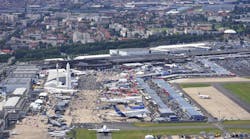GENEVA - The model of an adjustable plane, with wings that can be attached to for instance train compartments, will be shown at the Paris Air Show next week, the Swiss inventors said Monday.
The "Clip-Air" project is fresh off the drawing board and features a single flying wing that could be clipped onto for instance train "capsules" carrying passengers or cargo, the EPFL technical university in Lausanne said in a statement.
"More than a new type of flying device, its innovative concept could revolutionize the airports of the future," it said.
In a future of Clip-Air planes, people would be able to "go to the train station to take the plane. Board on a capsule to reach the airport by rail, and then - without leaving (their) seat - fly to another city," it said.
EPFL acknowledged that the project it had been working on since 2009 remained "very futuristic," but stressed that its scientists were convinced it was technically feasible.
"We still have to break down several barriers but we do believe that it is worth (working on) such a concept, at odds with current aircraft technology and which can have a huge impact on society," project chief Claudio Leonardi said in the statement.
The model to be shown for the first time at the Paris Air Show next week will represent a flying wing which can hold up to three capsules, each with the capacity to carry 150 passengers.
In addition to allowing "more efficient and flexible fleet management," and allowing airlines to kiss the days of empty flights goodbye, the engineers have also calculated that Clip-Air planes would be far more fuel efficient.
"Clip-Air aircrafts' conventional fuel consumption would be reduced since they can carry as many passengers as three A320 with half the engines," EPFL said, adding that the scientists were also looking into alternative, less polluting fuels for the planes.
Perhaps the most exciting aspect of the project was the potential to "revolutionize airport configuration," the Lausanne school said.
The capsules, measuring around 30 meters and weighing about 30 tons, would fit in airports the way they are built today, but would also be compatible with rail tracks, it said, meaning "the boarding of either cargo or passengers in the capsule could be done not only at airports but also directly in rail stations or production sites."
Copyright Agence France-Presse, 2013




